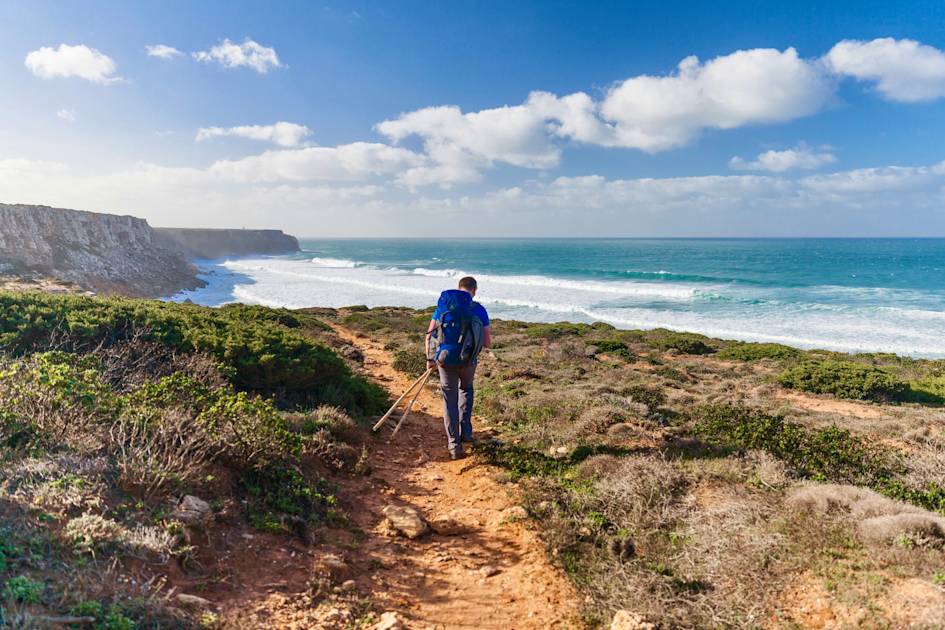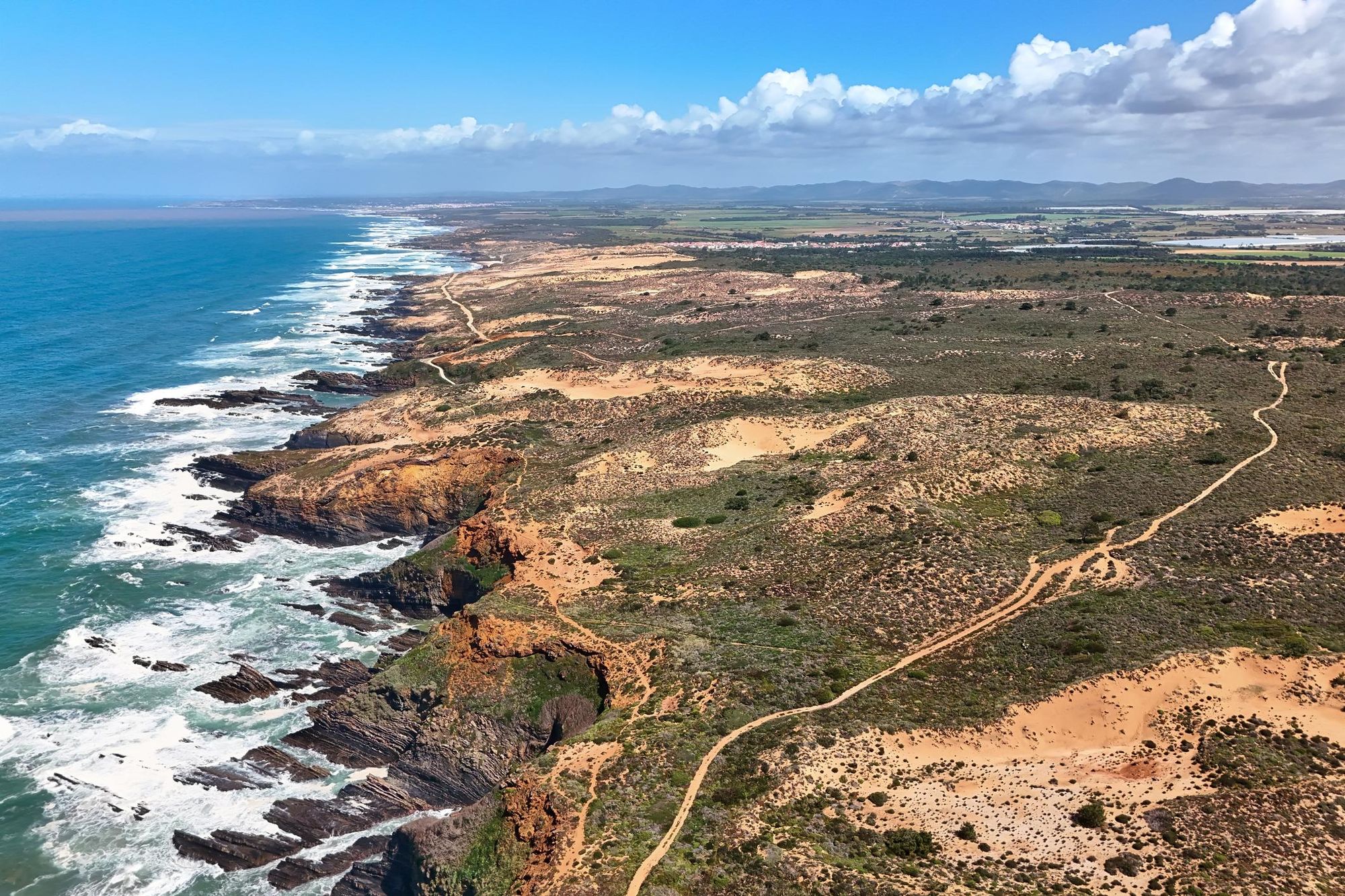The waters of the Atlantic wash up against the sandy beaches of the Algarve, cordoned off from the world by rocky, rugged cliffs. Surfers bob about in the line up, waiting on the next wave, while swimmers dip in and out of the ocean. Along the coast, lanky white storks nest amongst sea stacks. “It’s the only place in the world where they make their nests in the cliffs,” says Luis Coelho, who has worked in tourism in his native Portugal for decades.
This is the very edge of the European continent. Beyond those surfers lies only water, the Azores and America. It’s easy to lose yourself in that thought.
We look for the guy or woman who produces cheese and bread in his courtyard, or who has some bees and lovely honey. We're always looking for these local experiences.
Back in the other direction, inland, the cliffs plateau and then gently undulate, rolling into the Portuguese mainland. There gravel tracks run through cork, pine and Medronho trees, in quiet agricultural land. This is where an older Portugal still exists, in dusty towns rich in historical practises and local artisanship.
Welcome to the Rota Vicentina, a long-distance network of walking and cycling routes which runs through the regions of Alentejo and Algarve in the southwest.

There are three main hiking options under the umbrella of Rota Vicentina.
The first are the circular routes, allowing you to stay in one location and embark on day hikes. The second option is The Historical Way. “It’s inland,” says Luis. “If you want to see rural aspects of Portugal like cork tree production, it’s ideal.”
The third option is the best known route of the Rota Vicentina. It’s called The Fisherman’s Trail, and it is the most demanding, and most popular, of the three.

“Fishermen still use access points in the cliffs to reach the beaches and the sea,” says Luis, of the 140 mile (226.5km), 12-stage trail. “The concept in the beginning was that if you can link all of these, from Sines to Lagos, you can walk along the coast for 14 days or more. It’s amazing, because it’s a protected area. You walk along the coast, and if you decide you want to go to a beach for a dip, or find a whole beach for yourself, simple. You can find a place that is just for you.”
Coelho is the co-founder of Portugal A2Z Walking & Biking, and the co-creator of Much Better Adventure’s new six-night hike on the Rota Vicentina, exploring the Algarve’s hidden coves and sleepy villages along the way. “If you want big groups, we don’t do it,” he says. “If you want to go to the most common places in Portugal, where people go for an Instagram picture but don't care about the communities - we don't do it. We organise hikes with a cultural aspect. We look for the guy or woman who produces cheese and bread in their courtyard, or who has some bees and lovely honey. We're always looking for these local experiences.”


The trails are managed by the Rota Vicentina Association, who were set up to encourage tourism beyond the summer months, and to spread the wealth that comes with it to inland villages, many of which are being slowly depopulated due to a lack of opportunities, causing people to leave for Porto or Lisbon.
“The aim is to help the region in the southwest of Portugal, which is mostly a natural park,” Luis says. “The aim of the trail, when it was built, was to fight against regular summer tourism. 11 years ago, if you came in July and August everything was crowded, but for the rest of the year, all of the accommodation would be empty; except for the occasional foreigner or Portuguese tourist.
“It’s a lovely project. You go from one accommodation to another, hiking between 15-25km (9-15 miles) each day and during the walk you have places where you can stop for a cafe or a beer.
“It’s all about getting people off the beaten path and trying to sustain people. We go to small cafes that are popular in summer but in winter have no income. There are a lot of small, small places in Portugal where people still live without the internet, far from any Instagram stories.”

The Fisherman’s Trail rarely leaves the coast, but Luis advocates for staying inland at night, to support the communities looking to flourish in rural areas.
“Don't keep all of the tourism in Portugal on the coast,” he says. “Go inland, because you want to support the communities. We have a country full of rewilding areas, but often with nobody there. We need balance, because if people are there, they also take care of the environment.”
I ask Coelho to describe some of the highlights along the Fisherman’s Trail.
It’s all about getting people off the beaten path and trying to sustain people. We go to small cafes that are popular in summer but in winter have no income.
“When you hike from Arrifana to Carrapateira, most of the time you will be near the coast,” he says. “This is a really rough coast. There is some hiking inland, a lot of rock rose, or cistus, which are common flowers, and a lot of cork trees and umbrella pine trees, which produce the pine nuts that you use in pesto. You can still see shepherds and their cows. So what you have is this mixture of coastal views and small valleys, with dunes as you arrive into Carrapateira.”
That night, you can stay at a regenerative tourism project called Pedralva.
“20 years ago, a man called Antonio [Ferreira] decided to buy some houses in-land, in an abandoned village, and started to rebuild it. Today, when you visit you don’t stay in a room, but in a small, white-washed house. Some of them have four rooms and they are named after local beaches.”

The internet is weak and the phone coverage is poor. “So if you want to rest, it's perfect,” Luis says. “There is a lovely restaurant. It’s great for a group dinner.”
Naturally, seafood is the pick here. “Fresh fish is extremely common and you’ll see people out fishing. But since you are in the Algarve, there are also figs and almonds. The food is a mix between Islamic, European and African. It’s diverse.”

Near Pedralva is Praia do Amado, an idyllic beach known for its surfing, and Cabo de São Vicente (Cape St. Vincent), the southwestern tip of Europe lies within walking distance beyond. “It’s common to see some peregrine falcons on this walk, and this is where you can see storks nesting in the cliffs,” says Coelho.
Cape St. Vincent is one of the continent’s most storied spots. There are temples dedicated to Heracles and Romans once believed the sun sank into the ocean here, marking the edge of the world. Strabo, the ancient geographer, believed the place to be magical, and the current name is actually linked to a martyred fourth-century deacon, St. Vincent, whose body - the legend goes - was discovered by citizens of Portugal’s first monarch, King Alfonso I, guided by ravens to the spot.

There's history beyond that, too. “Even before you reach Cape St. Vincent, you have Telheiro Beach, which is a great place for people who love rocks,” says Luis. “You have rocks from 300 million years ago to 20,000 years.”
The route takes in Sagres, which was once home to Prince Henry the Navigator's 15th-century School of Navigation. “It’s an easy-going place,” Luis says. "There are small bars with live music; fancy restaurants and small, romantic ones."
From Sagres to Salema is one of the most challenging sections of the trip. “But for sure, it is one of the best,” Coelho adds. “When you come to the cliffs and coast, it’s up and down and up and down. If it’s high tide, we stay on the cliffs, but if you see a beach, we can stop and go for a dip.”
The hike concludes on a flatter section, passing Luz and Ponta de Piedade, near where small boats run daily tours to see the caves. The journey ends in Lagos, from where it’s a simple exit for those departing to Faro Airport, an hour east.
The Rota Vicentina is a showcase of this storied region, from past and present Portugal, feeding a future of tight communities, based on or near the open coast.
Inspired? Check out our small group tours in Portugal now, in particular our adventure on the Rota Vicentina!


